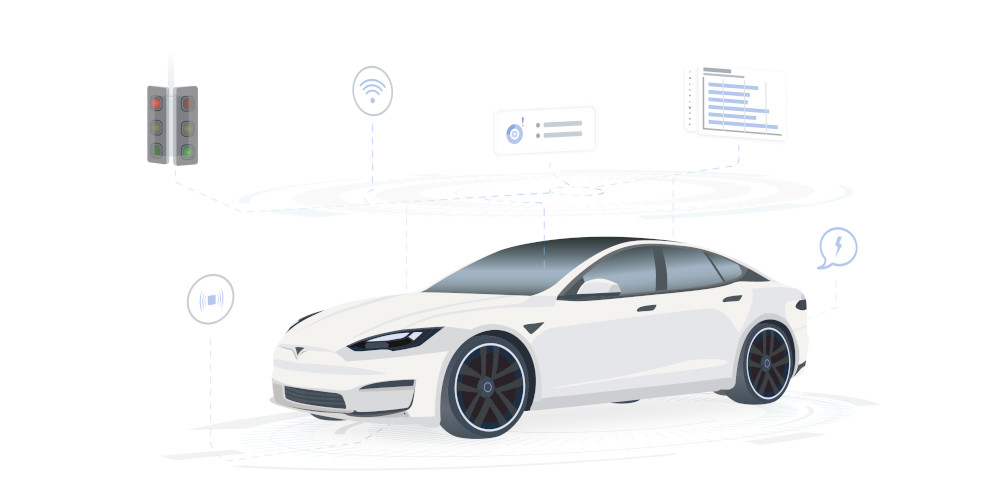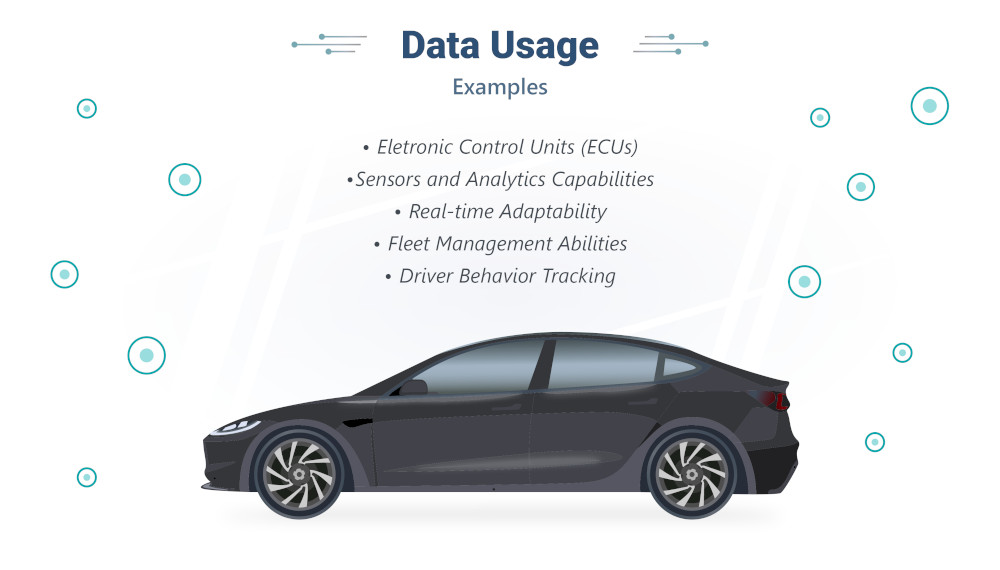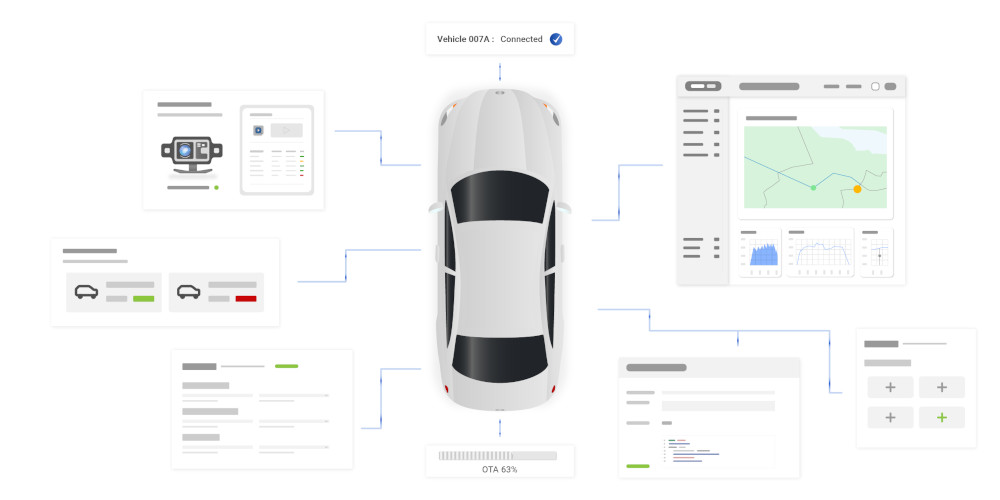Modern vehicles operate as distributed computing platforms that generate a continuous stream of vehicle data. Every second, the powertrain, chassis, safety systems, and infotainment units publish signals describing engine load, temperatures, GPS position, battery state, and hundreds of ECU parameters. When this data is captured and interpreted correctly, it supports concrete outcomes such as fewer roadside failures, faster diagnostics, safer driving policies, and measurable fuel or energy savings. When it is ignored or locked in silos, costs increase and minor issues gradually turn into extended downtime.
This guide explains what vehicle data includes, how it is produced on CAN and OBD-II layers, where to access it, and how to use it without introducing unnecessary privacy or security risk. It is written for drivers who want a clearer view of vehicle health and for fleets that require repeatable processes, clean exports, and verifiable audit trails. Throughout the guide, you will see how AutoPi devices and AutoPi Cloud provide a standards-based way to collect, normalize, govern, and act on the signals you already own.
What is Vehicle Data?
Vehicle data is best understood as a layered model. At the lowest layer, physical sensors and ECUs publish raw signals on the in-vehicle network. Above this, standard access methods such as OBD-II PIDs, SAE J1979, J1939, and UDS expose diagnostic, emissions, and operational information. On top of these technical layers sit applications that correlate timestamps, locations, driver context, and asset metadata so that a single parameter such as RPM, coolant temperature, or state of charge becomes a meaningful event such as idling, harsh acceleration, over-temperature operation, or charge session efficiency. Thinking in layers prevents confusion between raw signals and the operational outcomes you care about.
Available parameters differ by make, model, year, region, and powertrain. A robust approach starts with a portable core set of signals, then extends into manufacturer specific messages where additional visibility is required. Hardware with CAN and CAN FD support, combined with a cloud backend that can normalize signals across mixed fleets, provides a consistent backbone for reporting and analytics while still allowing deeper engineering analysis when needed.
Types of Vehicle Data
Each category of vehicle data supports specific decisions. Engine and performance metrics drive maintenance scheduling and asset health monitoring. Fuel and energy data supports cost and efficiency analysis. GPS and trip data supports routing, utilization, and geofencing. Safety, fault, and diagnostic data supports compliance, warranty, and repair workflows. Use the table below as a structured overview of inputs you can combine to answer operational questions rather than as a list of isolated values.
| Category | Types of Data |
|---|---|
| Engine and Performance Data | RPM, temperature, throttle position, torque, load, fuel consumption |
| Fuel and Energy Data | MPG or kWh per 100 km, fuel level, fuel pressure, energy use per trip |
| Location and GPS Data | GPS coordinates, speed, heading, trip timelines, dwell time |
| Safety and Diagnostic Data | Diagnostic trouble codes (DTCs), ABS performance, airbag status, stability control events |
| Usage and Driving Behavior Data | Acceleration, braking, cornering, idle time, driving patterns, harsh events |
| Infotainment and Connectivity Data | Navigation usage, Bluetooth connectivity, media usage, hands free calls |
| Vehicle Identification and Configuration Data | VIN, model, model year, engine type, battery pack configuration |
Tables help you inventory what exists, but most value comes from correlation. A simple example is combining coolant temperature, ambient temperature, and grade to detect early cooling system degradation. Another is pairing odometer deltas with ignition cycles and dwell time to separate productive driving from extended idling. Thinking in pairs and triplets of signals is the fastest way to move from isolated readings to actionable insights.
In the sections that follow, you will see how each type of vehicle data supports practical use cases, from basic maintenance to advanced fleet optimization.
Understanding these data types provides a foundation for improving vehicle performance, safety, and lifecycle cost management.
-
Engine and health metrics can indicate when it is time for service or when a mechanical issue is developing.
-
Real-time fuel or energy data allows drivers and fleet managers to adjust operating patterns to reduce consumption.
-
Safety and DTC data highlight critical system faults and confirm that safeguards are operating as intended.
Structured vehicle data gives you a measurable basis for decisions about usage, maintenance, and renewal instead of relying on assumptions or manual logs.

Why Vehicle Data Is Important
The impact of clean, well structured vehicle data compounds over time. Faster triage and fewer inspection disputes free your team to focus on coaching, route design, and asset planning. More accurate fuel or energy baselines make savings programs credible and traceable. Consistent logs reduce surprises during roadside checks, warranty claims, or customer audits. These gains depend on collecting the right fields with reliable timestamps, enforcing quality rules, and preserving an audit trail that shows what changed, when it changed, and why.
Benefits of Vehicle Data for Car Owners
-
Enhanced driving experience
-
Real-time data on fuel efficiency and driving patterns supports more economical and predictable driving.
-
GPS and navigation data provide accurate routing and trip history, which simplifies planning and record keeping.
-
-
Improved safety
-
Safety data such as airbag status, ABS performance, and other ECU signals confirm that critical systems remain available when needed.
-
Alerts from diagnostic trouble codes (DTCs) highlight developing issues so they can be addressed before they escalate.
-
-
Personalized insights
-
Usage and driving behavior data provide feedback on braking, acceleration, and idling patterns that can be used to improve comfort, safety, and efficiency.
-
Infotainment and connectivity data can be used to tailor in-vehicle services and keep configurations consistent across trips.
-

Role of Vehicle Data in Maintenance and Diagnostics
Vehicle data is a primary input to both preventive and predictive maintenance strategies.
By continuously monitoring powertrain, chassis, and auxiliary systems, you can identify abnormal patterns early and schedule service on your terms rather than reacting to breakdowns.
Typical examples include:
-
Diagnostic trouble codes (DTCs). These codes indicate specific issues within the vehicle and allow technicians to quickly isolate the affected system or component.
-
Engine and performance monitoring. Tracking trends in temperature, boost, fuel trims, torque, and load exposes issues that are not yet visible to the driver.
-
Predictive maintenance. By analyzing historical data and usage patterns, predictive maintenance models can estimate remaining useful life for components and schedule replacements before failure.
Handled correctly, vehicle data shifts maintenance from reactive repair to planned intervention, reducing downtime and improving safety and customer experience.
Access Methods and Protocols
There are three common paths to collect vehicle data. The first is OBD-II, which provides standardized PIDs for emissions related diagnostics and basic powertrain metrics on light duty vehicles. The second is direct CAN or CAN FD access, which unlocks high resolution signals and advanced parameters for both light and heavy vehicles. The third is an OEM or platform API that aggregates data in the cloud. Many fleets combine these methods: hardware in the vehicle for real time visibility and offline coverage, and APIs for supplemental or historical information. Whatever you choose, ensure that events are time synchronized, data is buffered when coverage is weak, and exports follow consistent formats.
For heavy duty fleets, J1939 provides a common language on the CAN bus, while UDS enables deeper diagnostics and firmware related services. For light duty, SAE J1979 defines the OBD-II service modes and parameter sets. Devices that support these standards plus CAN FD allow you to introduce new vehicle classes without redesigning your data pipeline.
EV Data You Should Track
Electric vehicles produce a different set of high value signals. State of charge, battery temperatures, cell voltage spread, charge rate, and charger type describe both available range today and long term battery health. Charge session logs that include start SOC, end SOC, energy delivered, duration, and ambient conditions help planners select the right charging windows, avoid unnecessary fast charging, and validate that vehicles leave depots with the expected range.
Monitoring the variance between indicated range and actual consumption is equally important. Persistent drift may indicate calibration issues, battery degradation, or usage patterns that differ from the assumed drive cycle. Capturing this data at the edge and aggregating it in AutoPi Cloud makes it possible to benchmark different routes, vehicles, and seasons with the same methodology.
Data Quality You Can Trust
Decision quality is limited by data quality. Establish a consistent time base using GNSS or NTP and make it part of every record. Select sampling rates that match the question you want to answer, then apply basic filtering or hysteresis to remove noise without hiding important transitions. Track device health metrics such as GPS lock, modem RSSI, storage pressure, and device temperature so that you can detect gaps before they affect reports. Finally, validate that units, scaling, and sign conventions are correct, especially when combining OEM specific signals with standardized fields.
In practice, fleets use high quality EV and combustion vehicle data to shape routes around reliable fuelling and charging, to minimize cold or hot operation, and to keep components within temperature and load windows that preserve lifetime. Combined with location, dwell, and driver assignment data in AutoPi Cloud, these signals make it straightforward to spot inefficient stops, confirm that policies are followed, and measure how external conditions influence consumption.
What Data Does My Car Collect?
Your car continuously collects data to monitor and control performance, safety, and driver experience.
Modern vehicles rely on an array of sensors, ECUs, and communication buses that work together to generate this data.
Each type of data has a defined function in the control strategy, and many are available for structured collection when you connect the right tools.
Here is a breakdown of key data categories, how they are generated, and how they are typically extracted:
| Category | Types of Data | How It Is Generated | How It Is Extracted |
|---|---|---|---|
| Engine and Performance Data | RPM, temperature, throttle position, fuel consumption | Generated by engine sensors and control units monitoring combustion, airflow, and torque demand | Extracted via OBD-II, CAN or CAN FD telematics devices, or workshop diagnostic tools |
| Fuel and Energy Data | MPG or efficiency index, fuel level, fuel pressure, energy per trip | Calculated by fuel sensors, flow meters, and onboard computers combining distance and consumption | Extracted through instrument cluster, OBD-II, or cloud connected telematics solutions |
| Location and GPS Data | GPS coordinates, speed, trip segments, dwell time | Generated by GNSS modules and speed sensors tracking movement and stops | Extracted via in-car navigation, telematics devices, fleet platforms, or mobile apps |
| Safety and Diagnostic Data | DTCs, ABS events, airbag status, stability control interventions | Collected by safety ECUs and diagnostic modules monitoring thresholds and faults | Extracted using OBD-II and UDS tools, dealer equipment, or connected diagnostic platforms |
| Usage and Driving Behavior Data | Acceleration, braking, idle time, driving patterns | Monitored by accelerometers, brake sensors, and ECUs that evaluate driver input and motion | Extracted through telematics systems, usage based insurance devices, or fleet platforms |
| Infotainment and Connectivity Data | Audio preferences, paired devices, navigation usage | Recorded by infotainment systems and connectivity modules logging user interactions | Accessed through infotainment interfaces, OEM portals, or connected mobile applications |
| Vehicle Identification Data | VIN, model, configuration codes | Stamped on the vehicle, encoded in ECUs, and stored in registration systems | Extracted through visual inspection, VIN scanners, OBD-II, or vehicle history and OEM systems |
This table provides a concise snapshot of key vehicle data categories, their technical origin, and typical access methods.
When combined in a single platform, this information supports better maintenance planning, performance analysis, and overall vehicle management.

Who Uses Vehicle Data and How It Benefits Them
Vehicle data is used by a wide range of stakeholders to improve safety, performance, cost, and compliance.
The same underlying signals can support very different use cases, depending on how they are combined and presented.
Car Owners and Drivers
-
Maintenance and diagnostics. Monitor vehicle health, receive alerts, and provide workshops with structured fault information.
-
Driving behavior. Improve habits for better safety, comfort, and fuel or energy efficiency.
-
Real time monitoring. Receive relevant alerts about critical events instead of relying only on warning lamps.
Mechanics and Service Centers
-
Efficient diagnostics. Use OBD-II data and advanced protocols to shorten fault finding time and avoid unnecessary parts replacement.
-
Predictive maintenance. Analyze patterns across vehicles to identify recurring issues and optimize service intervals.
Car Manufacturers and Developers
-
Product improvement. Use aggregated and anonymized field data to improve future models and software updates.
-
New features. Develop connected services and in-vehicle functions based on real usage patterns rather than assumptions.
Insurance Companies and Fleet Managers
-
Usage based insurance (UBI). Offer pricing that reflects driving behavior and exposure rather than only static risk factors.
-
Fleet management. Monitor fleet performance, enforce policies, optimize routes, and reduce fuel and maintenance costs.
Practical Applications of Vehicle Data
-
Real time monitoring. Track vehicle health and key events as they occur and notify responsible teams.
-
Predictive maintenance. Use historical data to anticipate failures and schedule interventions before breakdowns.
-
Navigation and traffic management. Use GPS data for accurate routing, route compliance, and congestion analysis.
-
Insurance telematics. Align insurance pricing with measured risk rather than only static driver attributes.
-
Fleet optimization. Increase utilization, reduce idle time, and benchmark vehicles or routes against each other.
With the right collection and governance framework, vehicle health, safety, and operating cost can all be managed using the same underlying dataset.
Accessing Your Vehicle Data: A Step-by-Step Guide
With the right hardware and platform, accessing your vehicle data becomes a repeatable process instead of a one-off workshop activity. The steps below outline how to capture and use vehicle data with an AutoPi device and AutoPi Cloud.
Step 1: Get the AutoPi Device
The AutoPi device is a smart, configurable platform that connects to your vehicle through OBD-II or a dedicated harness, enabling direct access to CAN and OBD-II data.
-
Select and purchase a device
-
Visit the AutoPi hardware overview and choose the device that matches your vehicle type and use case.
-
Complete the purchase and shipping process according to your region and deployment size.
-
-
Install the device
-
Locate the OBD-II port or dedicated connector in your vehicle.
-
Plug in the AutoPi device or connect the appropriate harness.
-
Ensure the device powers up and has access to the vehicle network.
-
Step 2: Set Up AutoPi Cloud
AutoPi Cloud is the management and analytics layer that receives, stores, and visualizes vehicle data from your devices.
-
Create an AutoPi Cloud account
-
Contact us to obtain access to AutoPi Cloud.
-
Complete the registration flow and verify your email address.
-
-
Link your AutoPi device to AutoPi Cloud
-
Sign in to your AutoPi Cloud account.
-
Follow the prompts to register and link each device to your account or tenant.
-
Ensure the device has a working internet connection through Wi-Fi or cellular.
-
Step 3: Access Your Vehicle Data
Once devices are connected and linked, data collection and visualization become routine activities.
-
Log in to AutoPi Cloud
-
Use your credentials to sign in and select the relevant fleet, group, or vehicle.
-
-
Use the dashboard
-
Review real time data, trip logs, and state summaries on the dashboard views that match your role.
-
-
Explore detailed insights
-
Inspect engine performance, fuel or energy consumption, GPS history, and driver behavior at the level of a single trip or an entire fleet.
-
Use diagnostic views to understand DTCs and other fault indicators before sending vehicles to the workshop.
-
Step 4: Utilize Vehicle Data
With structured vehicle data available, you can embed it into your operational processes instead of treating it as a side activity.
-
Monitor vehicle health
-
Configure alerts for critical conditions such as over temperature, low SOC, or recurring DTCs.
-
Track performance trends over time to detect degradation rather than waiting for failures.
-
-
Improve driving habits
-
Analyze driving behavior data and use it in coaching, training, or incentive programs.
-
Focus on events that have measurable impact such as harsh braking, harsh acceleration, and excessive idling.
-
-
Plan and optimize trips
-
Use GPS and trip data to validate planned versus actual routes and identify systematic detours or delays.
-
Combine dwell, loading, and traffic patterns to optimize schedules and depot operations.
-
-
Perform diagnostics
-
Use DTCs and related telemetry to triage issues remotely before vehicles arrive at the workshop.
-
Prioritize repairs based on severity and safety impact rather than only on driver reporting.
-
Step 5: Customize and Expand
AutoPi is designed to integrate with existing systems and workflows rather than behaving as a closed endpoint.
-
Add custom scripts and features
-
Use AutoPi Cloud to create and deploy custom scripts, triggers, and integrations that run on the device or in the cloud.
-
Connect AutoPi with other internal systems, such as maintenance platforms, data lakes, or BI tools.
-
-
Stay updated
-
Keep device firmware and configurations up to date to benefit from new capabilities and security improvements.
-
Follow standard security practices for account management and access control in AutoPi Cloud.
-
For more detailed instructions and advanced use cases, visit the AutoPi Documentation. If you have any questions or require implementation support, please contact us. Our team can help you design a deployment that fits your specific vehicles, workflows, and compliance requirements.
By following these steps, you can turn raw vehicle data into a managed asset that supports smarter operations and a more predictable driving and ownership experience.






